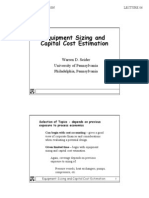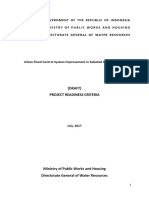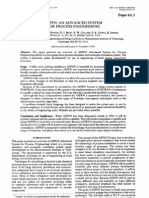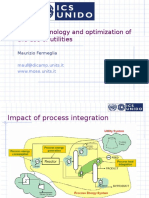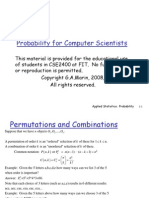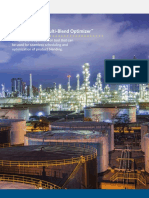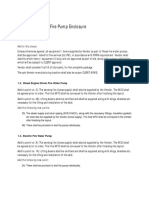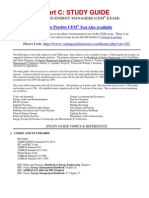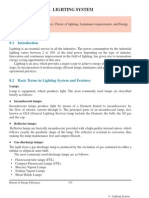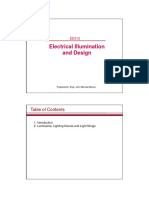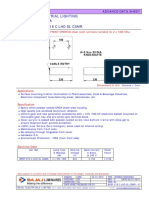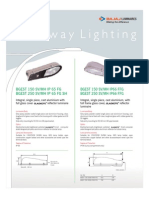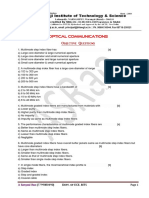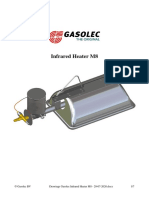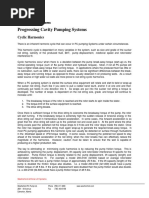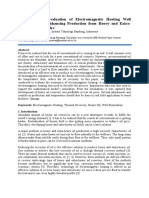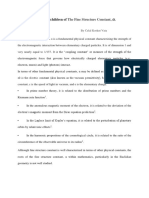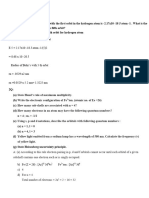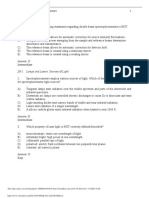Lighting Systems
Lighting Systems
Uploaded by
Suhas AcharyaCopyright:
Available Formats
Lighting Systems
Lighting Systems
Uploaded by
Suhas AcharyaOriginal Description:
Copyright
Available Formats
Share this document
Did you find this document useful?
Is this content inappropriate?
Copyright:
Available Formats
Lighting Systems
Lighting Systems
Uploaded by
Suhas AcharyaCopyright:
Available Formats
Selected questions
Chapter 4.10: Lighting Systems Short type questions 1. Define Installed Load Efficacy? Ans. Installed Load Efficacy is the average maintained illuminance provided on a horizontal working plane per circuit watt with general lighting of an interior. Unit: lux per watt per square metre (lux/W/m) 2. Define Lamp Circuit Efficacy? Ans. Lamp Circuit Efficacy is the amount of light (lumens) emitted by a lamp for each watt of power consumed by the lamp circuit, i.e. including control gear losses. This is a more meaningful measure for those lamps that require control gear. Unit: lumens per circuit watt (lm/W) 3. Define Installed Power Density? Ans. The installed power density per 100 lux is the power needed per square metre of floor area to achieve 100 lux of average maintained illuminance on a horizontal working plane with general lighting of an interior. Unit: watts per square metre per 100 lux (W/m/100 lux) N.B. Installed power density (W/m/100 lux) = 4.
100 Installed load efficacy ( lux / W / m)
What do you understand by Colour Rendering Index? Ans. Colour Rendering Index (CRI) is a measure of the effect of light on the perceived colour of objects. To determine the CRI of a lamp, the colour appearances of a set of standard colour chips are measured with special equipment under a reference light source with the same correlated colour temperature as the lamp being evaluated. If the lamp renders the colour of the chips identical to the reference light source, its CRI is 100. If the colour rendering differs from the reference light source, the CRI is less than 100. A low CRI indicates that some colours may appear unnatural when illuminated by the lamp.
5.
Define Room Index and minimum number of measurement points? Ans. Room Index is defined as follows: Room Index: RI =
LxW Hm (L + W )
Where L = length of interior; W = width of interior; Hm = the mounting height, which is the height of the lighting fittings above the horizontal working plane. The working plane is usually assumed to be 0.75m above the floor in offices and at 0.85m above floor level in manufacturing areas. It does not matter whether these dimensions are in metres, yards or feet as long as the same unit is used throughout. The minimum number of measurement points can be ascertained from the table below:
4.10 - Lighting systems (table format)
59
Selected questions
6.
What is installed load efficacy ratio? Ans. Installed load efficacy ratio (ILER) = Actual Lux / W / m T arg et Lux / W / m
Or Installed load efficacy ratio (ILER) =
7.
T arg et W / m / 100 lux Actual W / m / 100 lux
Write the CRI values for excellent, good, moderate, poor and none performance sources? Ans. Condition Excellent Good Moderate Poor None CRI Value > = 90 80 89 60 79 40 59 20 - 39
8.
What is meant by circuit Watts?. Ans. Circuit Watts is the total power drawn by lamps and ballasts in a lighting circuit under assessment.
9.
How is the lighting performance assessed from Installed load efficacy ratio (ILER)?? Ans. ILER ratios of 0.75 or more may be considered to be satisfactory to good. Existing installations with ratios of 0.51 0.74 certainly merit investigation to see if improvements are possible. Of course there can be good reasons for low ratio, such as having to use lower efficacy lamps or less efficient luminaries in order to achieve the required lighting result but it is essential to check whether there is scope for a more efficient alternative. Existing installations with an ILER of 0.5 or less certainly justify close inspection to identify options for converting the installation to use more efficient lighting equipment.
10.
The ILER of a room is 0.7. If the lighting load is 990 W, calculate the annual energy wastage? Assume the room is ON for 8hours/day for 300 days Ans. Annual Energy Wastage = (1 ILER) x Watts x no. of operating hours = ( 1 0.7 ) x 990 x 8 hours/ day x 300 days = 712 kWh/ annum
4.10 - Lighting systems (table format)
60
Selected questions
Long type questions 1. What are the differentiating characteristics of incandescent, compact fluorescent lamp, and highintensity discharge (HID) lamps? Ans. Incandescent lamps: Appear "warm" in colour and have excellent colour rendering. Are the least efficient of general lamp types due to the amount of energy consumed heating the filament in order for the lamp to turn incandescent Have a short lamp life of between 500 and 1,000 hours. Are easy to install because no ballast is required. Are available in a complete range of colour combinations. Produce low heat. Require a more extensive installation because ballasts are a necessary part of the fixture. Have an extremely long life of up to 24,000 hours. Due to smaller sizes and screw base/pin type base features, compact fluorescent lamps can replace incandescent lamps. Are ideal for large stores, warehouses, auditoriums, outdoor parking areas, and applications where efficiency is a priority. Have a warm-up period, which results in slower start-up. Deliver a large amount of light over a wide area. Have a long life of between 5,000 and 24,000 hours. Require ballasts.
Compact Fluorescent lamps:
High-intensity discharge (HID) lamps: 2.
Describe in short on the following common lighting control tools? a) b) c) Ans. a) Programmable Timers: Programmable timers are used to implement time-based control of electric lights. The usual method of implementation is a system of low-voltage controlled relays that are controlled by a programmable time clock. These systems are primarily used to efficiently schedule the operation of a lighting system in areas where the occupant schedule is relatively predictable. To accommodate lighting needs during off-hours, these systems are typically equipped with overrides so that building occupants can control the lights using a lowvoltage switch or a telephone override system. b) Occupancy Sensors: Occupancy sensors are switches that are activated by detecting the presence or absence of people in the sensor's field of view. There are two basic types of occupant sensor: passive infrared sensing and ultrasonic (some sensors combine these two methods). These sensors are most effective in locations where occupancy is not easily predicted (e.g., conference rooms, restrooms, and storerooms). c) Photo-Switches: Photo-switches are photo-electrically controlled switches that can be used to switch off lights in building zones receiving daylight from adjacent windows. These devices are usually installed in one of three ways: on each fixture; on groups of fixtures using intermediate Programmable timers Occupancy sensors Photo switches
4.10 - Lighting systems (table format)
61
Selected questions
relays; or as inputs to low-voltage programmable relay systems.
Numerical type questions 1. Two main areas of an industrial plant have the following lighting systems: Area A: 50 x 400W High Pressure Sodium (HPSV) single lamp luminaires. Area B: 35 x 400W Mercury Vapour (HPMV) single lamp luminaires. In Area A and Area B, the measured illuminance during daylight hours (12 hours) without artificial light was found to be adequate. In Area B it was noted that 8 of the MV fixtures are redundant. Plant Operating Hours: 24 hours per day, 365 days per year. Electricity Energy costs: Rs 3.00/kWh Calculate the annual potential energy cost savings from switching off unnecessary lights and from disconnecting redundant luminaires? Note: Ignore the ballast energy consumption. Area A Energy Savings: The annual energy saved by switching 50 x 400W HPSV lights off for the 12 hours of daylight time each day is: =
50 x 400 W x 12 h / d x 365 d / y 1000
87,600 kWh
The cost of the annual saved energy is: 87,600 x Rs. 3.00 /kWh = Rs. Area B Energy Savings The annual energy saved by removing 8 redundant 400W HPMV luminaires is: = 262,800/-
8 x 400 W x 12 h / d x 365 d / y 1000
28,032 kWh
The annual energy saved by switching the remaining 27 x 400W HPMV lights off for the 12 hours of daylight time each day is:
4.10 - Lighting systems (table format)
62
Selected questions
27 x 400 W x 12 h / d x 365 d / y 1000
47,304 kWh
The total annual energy saved is :(28,032 + 47,304) kWh = 75,336kWh The cost of the annual saved energy is: 75,336 x Rs. 3.00/kWh = The overall cost of annual energy saved: = = Rs.262,800/- +Rs. 226,008/Rs. 488,808/Rs.226,008/-
4.10 - Lighting systems (table format)
63
Selected questions
2.
The exterior areas of a Compressor House are illuminated by twenty wall-mounted 1000W Tungsten Halogen, single lamp, luminaires. The lamps burn 12 hours a day, throughout the year. The energy and cost savings that could be realized by changing to a more efficient light source were investigated. With reference to data given below suggest the suitable retrofit for annual energy saving and the simple pay back period. Luminaire 1000 W Halogen lamp 250 W HPSV lamp 400 W Metal halide lamp Lumens 22,700 24,600 27,000 Efficacy 22.70 98.40 67.50 Cost /lamp Rs. 5000 Rs. 5500 Rs. 6500
Plant Operating Hours: 12 hours per day, 365 days per year. Electricity Costs: Rs 3.00/kWh Ans. From the given table the lumen output of 250 W HPSV is sufficient for retrofit and the efficacy is more than 4 times the efficacy of 1000 W Halogen lamps. Annual energy consumed by 1000 W Halogen lamps = =
20 x 1000 W x 12 h / d x 365 d / y 1000
87,600 kWh
Annual energy consumed by 250 W HPSV lamps on replacement = = = = Annual cost of energy saved = = = = Simple payback period = = = 3. Application = Industrial lighting Room Dimensions = 10 x 7 x 3 m Lighting load = 1000 W Average maintained illuminance = 500 lux, target lux/W/m2 (from table in the book for the room index) = 38
20 x 250 W x 12 h / d x 365 d / y 1000
21,900 kWh 87,600 21,900 kWh 65,700 kWh 65,700 x Rs. 3.00/kWh Rs. 197,100/20 x Rs. 5500 Rs. 110,000/Implementation cost Annual cost of energy saved 110,000 197,100 0.6 year
Annual energy savings by replacing with 250 W HPSV lamp
Cost of implementation of 20 Nos. 250 W HPSV lamp
4.10 - Lighting systems (table format)
64
Selected questions
Calculate (a) Room index (b) Watts/m2 (c) ILER Ans. (a) Room index = L x W / Hm (L+R) = 10 x 7 / 3 x (10+7) = 1.37 (b) Watts/m2 = 1000 / (10 x 7) = 14.3 (c) Actual lux/watt/m2 = 500 / 14.3 = 34.9 Target lux/W/m2 (from table in the book for the above RI) = 38 ILER = 34.9 / 38 = 0.92 (satisfactory to good) 4. An industrial plant has an incandescent lighting load of comprising 100 Nos. of 60 W and 140 Nos. of 100 W. Calculate the energy savings if each incandescent load is replaced by 1 X 40W fluorescent load. Lighting is required for 4000 hours/year and the cost of electricity is Rs. 4.0 per kWh. Replacement cost is Rs. 135 per unit consider ballast consumption as 15 W Given data: 100 W incandescent lamp 60 W incandescent lamp 40 W Fluorescent lamp Ans. Power required by existing incandescent lamps = = 100 x 60 + 140 x 100 6000 + 14000 = 20.0 kW = = = 2200 lumens 1320 lumens 2400 lumens
One 40 W fluorescent lamp each will be required to replace one 100 W incandescent and two of 60 W lamps (as observed from given data). we require 140 nos. of 40W fluorescent lamps and 50 Nos. of 100 watts fluorescent lamps. Total number of Fluorescent lamps required Power required for total fluorescent load Annual Energy Savings Annual cost savings Replacement cost Simple payback period = = = = = = 50 + 140 = 190 Nos. Power required for one of fluorescent lamp is 55 W (including conventional ballast power) 190 x 55 W = 10.45 kW (20 10.45) x 4000 = 38,200 kWh 38,200 x 4 = Rs. 1.53 lakh 190 x Rs. 135/unit = Rs.0.26 lakh 0.26/1.53 = 2 months
4.10 - Lighting systems (table format)
65
You might also like
- ENEN-635 Environmental Modeling Lab-2 Report - Rev1Document10 pagesENEN-635 Environmental Modeling Lab-2 Report - Rev1Muhammad NaeemNo ratings yet
- LECTURE 06 Equipment Sizing and Capital Cost EstimationDocument10 pagesLECTURE 06 Equipment Sizing and Capital Cost EstimationSomayeh SarabadanNo ratings yet
- Nonlinear ProgrammingDocument2 pagesNonlinear ProgrammingKristen ObrienNo ratings yet
- Bajaj High Mast CatalogueDocument2 pagesBajaj High Mast CatalogueSuhas Acharya50% (2)
- MP Notes PDFDocument160 pagesMP Notes PDFElumalaiNo ratings yet
- Case Study of Pinch Analysis PDFDocument10 pagesCase Study of Pinch Analysis PDFDHAPA VISHALNo ratings yet
- Economic ReportDocument9 pagesEconomic ReportYeeXuan TenNo ratings yet
- Pinch Spreadsheet Nov06 FinalDocument97 pagesPinch Spreadsheet Nov06 FinalmadrasahNo ratings yet
- Process EcnomicsDocument17 pagesProcess EcnomicsFaris AhmedNo ratings yet
- 3.2 Electric Motors - Revised (Table Format)Document8 pages3.2 Electric Motors - Revised (Table Format)Sumit AgrawalNo ratings yet
- Project Readiness Criteria R1Document20 pagesProject Readiness Criteria R1MuhammadGaniNo ratings yet
- RABEGH Hydraulic Calculation 281219Document14 pagesRABEGH Hydraulic Calculation 281219Mostafa SharafNo ratings yet
- Mathematical Modeling, Simulation and Validation of A Boiler Drum: Some InvestigationsDocument33 pagesMathematical Modeling, Simulation and Validation of A Boiler Drum: Some InvestigationsMohammadreza NaghaviNo ratings yet
- Doc. No. 05 - 42 19 AB023 - FIDocument41 pagesDoc. No. 05 - 42 19 AB023 - FIAfanda Dwi R RNo ratings yet
- Aspen Utilities: The Challenge: Reduction of Production CostsDocument6 pagesAspen Utilities: The Challenge: Reduction of Production CostsqjjonesNo ratings yet
- Life CycleCarbonFootprintingandEconomicsDocument55 pagesLife CycleCarbonFootprintingandEconomicsAr Abhinav SrivastavNo ratings yet
- ire Load CalculationDocument1 pageire Load Calculationyerrisiddappa KNo ratings yet
- 05 Plant Design and Economics Cost Estimation R00Document125 pages05 Plant Design and Economics Cost Estimation R00هادی طاهریNo ratings yet
- Presentation For PSA Medical Oxygen GeneratorsDocument10 pagesPresentation For PSA Medical Oxygen GeneratorsrutujaNo ratings yet
- Florencio Favila III Updated ResumeDocument5 pagesFlorencio Favila III Updated ResumeBibamz SanchezNo ratings yet
- Pressure Ake Int Absolute Stage Last of Pressure e Arg Disch AbsoluteDocument8 pagesPressure Ake Int Absolute Stage Last of Pressure e Arg Disch Absolutemasih tadayonNo ratings yet
- Heat Integration-Chap4a LectureDocument33 pagesHeat Integration-Chap4a LectureNuruddin AzizNo ratings yet
- Lecture 8Document52 pagesLecture 8kere evaNo ratings yet
- Energy Conservation - High Temp CondensateDocument5 pagesEnergy Conservation - High Temp CondensateCalNo ratings yet
- Piping Flexibility ReportDocument608 pagesPiping Flexibility ReportEngr Khurram Jaan RamayNo ratings yet
- Chapter 11 - HeuristicsDocument39 pagesChapter 11 - HeuristicsFatthulHadiNo ratings yet
- Optimization of Multiple Effect Evaporators Designed For Fruit Juice Concentrate PDFDocument7 pagesOptimization of Multiple Effect Evaporators Designed For Fruit Juice Concentrate PDFFrancoNo ratings yet
- 3.4 HvacDocument8 pages3.4 HvacShehryar01No ratings yet
- Pinch Spreadsheet NOV06 FINALDocument194 pagesPinch Spreadsheet NOV06 FINALSzelee KuekNo ratings yet
- Vacuum: Technologies Technical Reference GuideDocument1 pageVacuum: Technologies Technical Reference GuideCalNo ratings yet
- HHV and LHVDocument2 pagesHHV and LHVYuji OhkusuNo ratings yet
- Typical Desuperheater Installations: Block 15Document10 pagesTypical Desuperheater Installations: Block 15Omprakash_janaNo ratings yet
- ECM Energy Audit ReportDocument4 pagesECM Energy Audit ReportJimit PatelNo ratings yet
- PG750B1 (GB) 1pp (0409)Document1 pagePG750B1 (GB) 1pp (0409)Ehsan Ur RehmanNo ratings yet
- ASPEN An Advanced System For Process Engineering 1979 Computers and Chemical EngineeringDocument9 pagesASPEN An Advanced System For Process Engineering 1979 Computers and Chemical EngineeringAshok PathakNo ratings yet
- 05 Pinch MFDocument41 pages05 Pinch MFrajat100% (1)
- 3 Papoulias, Grossmann (1983) - A Structural Optimization Approach in Process Synthesis II. Heat Recovery NetworksDocument15 pages3 Papoulias, Grossmann (1983) - A Structural Optimization Approach in Process Synthesis II. Heat Recovery NetworksAhmed Mohamed KhalilNo ratings yet
- Probability BasicsDocument174 pagesProbability BasicsAlelly Camille Pineda NodadoNo ratings yet
- Cyclohexane Production Process: Hydrogenation of Benzene: Maurizio FermegliaDocument20 pagesCyclohexane Production Process: Hydrogenation of Benzene: Maurizio FermegliaBüşraNo ratings yet
- Air Cooled Heat Exchanger: Shanghai Electric-SPX Engineering & Technologies Co., LTDDocument13 pagesAir Cooled Heat Exchanger: Shanghai Electric-SPX Engineering & Technologies Co., LTDibrahimNo ratings yet
- HYSYS Chemical Reactions & ReactorsDocument2 pagesHYSYS Chemical Reactions & ReactorspaldopalNo ratings yet
- Very Large Power System Operators in The WorldDocument79 pagesVery Large Power System Operators in The WorldParichay GuptoNo ratings yet
- Aspen Refinery Multi-Blend OptimizerDocument4 pagesAspen Refinery Multi-Blend OptimizerMaria OliveiraNo ratings yet
- Point To Be Focus On Review of Process Simulation ReportDocument3 pagesPoint To Be Focus On Review of Process Simulation ReportAsho AshourNo ratings yet
- PSR PPSXDocument19 pagesPSR PPSXpmahesh268No ratings yet
- Steam Turbines: An Introductory Guide To Steam Turbines For Chemical EngineersDocument28 pagesSteam Turbines: An Introductory Guide To Steam Turbines For Chemical EngineersFaisal Hayat Baloch100% (1)
- Design Criteria and Simulation of Flare Gas Recovery System: M. Enayati Sangsaraki, and E. AnajafiDocument5 pagesDesign Criteria and Simulation of Flare Gas Recovery System: M. Enayati Sangsaraki, and E. AnajafiShamsMohdNo ratings yet
- Fire Pump SpecificationDocument5 pagesFire Pump SpecificationThiru AnanthNo ratings yet
- Optimizing Condenser Water Flow RatesDocument12 pagesOptimizing Condenser Water Flow RatesNakkolopNo ratings yet
- Cem Studyguidepartc PDFDocument15 pagesCem Studyguidepartc PDFAnonymous PkeI8e84RsNo ratings yet
- Pinch TechnologyDocument38 pagesPinch TechnologyPankaj VermaNo ratings yet
- Economics TowlerDocument158 pagesEconomics Towlersnoopdogg89fakeNo ratings yet
- Lighting Systems: Short UestionsDocument7 pagesLighting Systems: Short Uestionsdeekshitagadi2302No ratings yet
- 3.8 Lighting SystemDocument7 pages3.8 Lighting SystemRaghav RaoNo ratings yet
- Electric LightingDocument10 pagesElectric LightingSarah FrazierNo ratings yet
- Report DesignDocument81 pagesReport DesignMUHAMMAD MUNIR ASYRAF BIN AB RAZAK STUDENTNo ratings yet
- 15 Technical PDFDocument26 pages15 Technical PDFAhmad Hamouda100% (1)
- 3Ch8 - 8. LIGHTING SYSTEM PDFDocument11 pages3Ch8 - 8. LIGHTING SYSTEM PDFstarykltNo ratings yet
- Hospitals: A Guide To Energy Efficient and Cost Effective LightingDocument6 pagesHospitals: A Guide To Energy Efficient and Cost Effective LightingMaha RahhalNo ratings yet
- 4 Lighting Systems 2Document7 pages4 Lighting Systems 2malusonprinscoNo ratings yet
- LightingDocument12 pagesLightingMayank DubeyNo ratings yet
- Bajaj Lighting CatalogDocument1 pageBajaj Lighting CatalogSuhas AcharyaNo ratings yet
- Wipro Lighting Catalogue PDFDocument76 pagesWipro Lighting Catalogue PDFSuhas Acharya100% (5)
- Robotics Program BrochureDocument2 pagesRobotics Program BrochureSuhas AcharyaNo ratings yet
- 04-Bajaj Bgemf 400 SVDocument1 page04-Bajaj Bgemf 400 SVSuhas AcharyaNo ratings yet
- 01-Bajaj Bgest 150 SV Ip65 FFGDocument1 page01-Bajaj Bgest 150 SV Ip65 FFGSuhas AcharyaNo ratings yet
- Stabilizing Resistor in Motor Earth-Fault ProtectionDocument12 pagesStabilizing Resistor in Motor Earth-Fault ProtectionSuhas AcharyaNo ratings yet
- Aberration at Shivaji Park: Sach MemoriesDocument1 pageAberration at Shivaji Park: Sach MemoriesSuhas AcharyaNo ratings yet
- Wipro Surface Mounted CrescentDocument4 pagesWipro Surface Mounted CrescentSuhas AcharyaNo ratings yet
- 9 Transformer Voltage DropDocument3 pages9 Transformer Voltage DropSuhas AcharyaNo ratings yet
- Digit AC Ammeter, VoltmeterDocument7 pagesDigit AC Ammeter, VoltmeterSuhas AcharyaNo ratings yet
- Havells Wire CatalogueDocument8 pagesHavells Wire CatalogueSuhas AcharyaNo ratings yet
- Phillips ObstiVision XGP+500Document5 pagesPhillips ObstiVision XGP+500suhasacharya117No ratings yet
- 66 KV 400sqmm Cable DataDocument2 pages66 KV 400sqmm Cable DataSuhas AcharyaNo ratings yet
- GE-Light Book 2013Document168 pagesGE-Light Book 2013Suhas AcharyaNo ratings yet
- Pages From 2011LEGOEducationMainDocument1 pagePages From 2011LEGOEducationMainSuhas AcharyaNo ratings yet
- GE-Light Book 2013Document168 pagesGE-Light Book 2013Suhas AcharyaNo ratings yet
- Electrical 00 IndexDocument1 pageElectrical 00 IndexSuhas AcharyaNo ratings yet
- Lego Early Simple MachinesDocument1 pageLego Early Simple MachinesSuhas AcharyaNo ratings yet
- Introduction To Electricity & Electrical Systems: Prelim Learning ResourcesDocument41 pagesIntroduction To Electricity & Electrical Systems: Prelim Learning ResourcesKib-anne Miguel PasikanNo ratings yet
- 10 Chapter 12 Balancing-StudentDocument82 pages10 Chapter 12 Balancing-StudentpayingintanNo ratings yet
- Science 5 - 3rd Quarter TestDocument7 pagesScience 5 - 3rd Quarter TestMaestro Sonny TVNo ratings yet
- Optical Communications: Objective QuestionsDocument13 pagesOptical Communications: Objective QuestionsAllanki Sanyasi RaoNo ratings yet
- 15 Days Checklist April 2024 - EdunitiDocument1 page15 Days Checklist April 2024 - Edunitimpandu2041No ratings yet
- Drawings Gasolec Infrared Heater M8 29 07 2020Document7 pagesDrawings Gasolec Infrared Heater M8 29 07 2020Cristina LimaicoNo ratings yet
- Progressing Cavity Pumping Systems: Cyclic HarmonicsDocument2 pagesProgressing Cavity Pumping Systems: Cyclic HarmonicsemmanuelNo ratings yet
- The Moxon Rectangle On 2 MetersDocument9 pagesThe Moxon Rectangle On 2 MetersStephen Dunifer100% (1)
- EE8702 Only4electrical - in Power System Operation and Control MCQDocument12 pagesEE8702 Only4electrical - in Power System Operation and Control MCQAmit MasareNo ratings yet
- Comprehensive Evaluation of Electromagnetic Heating Well Stimulation For Enhancing Production From Heavy and Extra-Heavy Oil ReservoirsDocument9 pagesComprehensive Evaluation of Electromagnetic Heating Well Stimulation For Enhancing Production From Heavy and Extra-Heavy Oil ReservoirsLeo Van GintingNo ratings yet
- Physics MS Set-1Document2 pagesPhysics MS Set-1Sam ImmanuelNo ratings yet
- Safety Issues Referred To Induced Sheath Voltages in High Voltage Power Cables Case Study - 50492Document16 pagesSafety Issues Referred To Induced Sheath Voltages in High Voltage Power Cables Case Study - 50492engmostafa darwishNo ratings yet
- Wave Speed, Frequency, PeriodDocument4 pagesWave Speed, Frequency, PeriodI Putu Yoga Widi LaksanaNo ratings yet
- Paper 4Document7 pagesPaper 4DavidNo ratings yet
- Transformers MCQ PDF (Erexams - Com)Document25 pagesTransformers MCQ PDF (Erexams - Com)yogeshNo ratings yet
- 3 UV IR NMR CD IssariyaDocument57 pages3 UV IR NMR CD IssariyaSonaliNo ratings yet
- π e and Ф as Grandchildren of the Fine Structure Constant α.Document14 pagesπ e and Ф as Grandchildren of the Fine Structure Constant α.Korkut VataNo ratings yet
- Electric Resistance - The Physics HypertextbookDocument5 pagesElectric Resistance - The Physics HypertextbookshiferawNo ratings yet
- Me Sci 8 q1 0704 PsDocument24 pagesMe Sci 8 q1 0704 PsGlydel PototNo ratings yet
- 10th Physics CH Wise Solved MCQDocument36 pages10th Physics CH Wise Solved MCQFun with HasaanNo ratings yet
- Beeme Unit 2Document28 pagesBeeme Unit 2thanushabaskarNo ratings yet
- 11 Ws CH 14 Oscillations QP 2023-24Document4 pages11 Ws CH 14 Oscillations QP 2023-24aarav28mNo ratings yet
- Sounder-Beacon D-145-155 - V3Document1 pageSounder-Beacon D-145-155 - V3nastyn-1No ratings yet
- 6.2 Stars & The UniverseDocument28 pages6.2 Stars & The UniverseHakim AbbasNo ratings yet
- Inductive Sensor NCB2-12GM35-N0-V1: DimensionsDocument3 pagesInductive Sensor NCB2-12GM35-N0-V1: DimensionsmhaioocNo ratings yet
- IAM Unit 4 MCQDocument4 pagesIAM Unit 4 MCQVishal SawantNo ratings yet
- Day1 1400 JohnPlacente MEA13 PDFDocument26 pagesDay1 1400 JohnPlacente MEA13 PDFdhanardkNo ratings yet
- At STRDocument5 pagesAt STRnivrutiverma1234No ratings yet
- Multiple-Choice: 20-1 Lamps and Lasers: Sources of LightDocument7 pagesMultiple-Choice: 20-1 Lamps and Lasers: Sources of LightBla NkNo ratings yet

